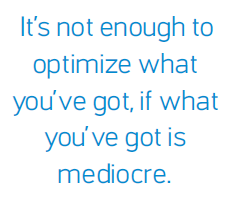Rethink Digital Strategy To Win Big

At its simplest, a business strategy must answer three questions: What the company goals are, how to achieve those goals and how an enterprise will sustainably beat the competition. Unfortunately, these responses typically don't drive promotional efforts, because many Internet professionals aren't thinking beyond their immediate needs: more leads, awareness, traffic and revenue.
Many, in fact, are so preoccupied in the everyday minutiae of running campaigns and reporting results that overarching business strategies get lost in the processes, which can decelerate growth and hinder long-term competitiveness. Don't let this happen to your digital enterprise; rethink your strategy.
Rethink the Definition of "Goals"
Who is your company? Where is it going? What is it trying to achieve? If you're struggling to answer these simple questions, you are not alone. When businesses think beyond their revenue, products and services and consider the greater impact they want to make on the world around them (digital or otherwise), they are positioned for greater success. As a key ingredient in rethinking strategy, you must also rethink the "bigger picture" purpose of your business.
IBM wants to build a smarter planet. Seventh Generation wants to inspire a revolution that nurtures the health of the next seven generations. These are clear and passionate "bigger pictures" that inspire and engage employees, customers, prospects and other stakeholders. IBM and Seventh Generation's strategies effectively integrate goals, purposes, missions and enthusiasms. Does yours?  Improving/increasing impressions, site traffic, page views, lead generation and cost per conversions are imperative and can accelerate business growth. However, only when companies rethink their strategies is it possible to increase positive results and do so exponentially. It's not enough to optimize what you've got, if what you've got is mediocre.
Improving/increasing impressions, site traffic, page views, lead generation and cost per conversions are imperative and can accelerate business growth. However, only when companies rethink their strategies is it possible to increase positive results and do so exponentially. It's not enough to optimize what you've got, if what you've got is mediocre.
In ex-Procter and Gamble CEO A.G. Lafley's new book "Playing To Win: How Strategy Really Works," Lafley and co-author Roger Martin highlight how Olay revived their stagnant brand, increasing revenue from $800 million to $2.5 billion within 10 years by changing the overall strategy. They envisioned a new future for the brand, focusing on fighting the signs of aging and creating a new market segment called "masstige" (mass market channels delivering a prestige brand). If they had instead relied on optimization without the optimal underlying strategy, they would have severely limited their progress.
Plan a successful future for your company by rethinking its business strategy, ensuring it clearly defines who your company is, what it stands for, where it is going and what success will look like when it arrives. This will produce better results from all marketing initiatives moving forward.
Rethink How Goals are Achieved
Next, rethink how you're doing what you're doing. Just because your team is working long hours doesn't mean you're maximizing results. Dramatically increase ROI by rethinking how marketing goals are achieved.
For example, a B2B software company, with much of its business sourced from overseas, conducted all of its international digital marketing in English. If it initially rethought its strategy, it would've been easy to see that they should test local language marketing to drive greater global opportunities.
Also, that same company targeted many countries simultaneously, spreading its budget thin. Instead of trying to be everywhere, it is now rethinking how to achieve its marketing goals, scaling back the number of countries to a select few. By rethinking the "how" it can focus marketing resources in the geographies that matter most, rather than just "being in the market" across a wider range of countries. Longer term, this more targeted approach will help in scaling more profitably and unleashing new development potential.
KISSmetrics, an analytics company, also rethought the "how" of achieving its goals. KISSmetrics aimed to be a thought leader and rethought the business-building process, essentially building this software company on top of its blog. Rather than taking a standard path for building a blog, though, they developed their own sophisticated methodology that included content creation, guest blogging and promotional components, as well as an analysis process using its own analytics software. The result was an increase (0 to 350,000) in monthly blog visitors. The blog now accounts for 82 percent of the company's site traffic and more than 70 percent of the company's leads.
As you consider the "how" of your implementation, keep your strategy in mind. Then, identify the marketing initiatives that will really move the needle.
Rethink How to Beat the Competition, Long Term
Audiences have a choice; they can buy from you or they can buy from the competition. Developing a plan to beat the competition continuously is critical to a winning strategy. Having a strategy like Olay's, provides a clear, sustainable tactical advantage over like brands.
As competitors change tactics, optimization efforts will need to be adjusted, continually. This is where a well-conceived strategy positions a brand for longer-term growth, regardless of tactics. In comparison, there's no single optimization tactic that can achieve that.
Look at the most successful companies in the world, including Apple, IBM and Google. They're actively aware of the competitive landscape and make informed decisions based on the marketplace. Steve Jobs was exceptionally effective at identifying a competitor's weakness and promoting Apple's differentiation of innovative products, ease-of-use and beautiful design.
With a strategic difference in hand, turn attention to articulating and proving that distinction in digital marketing efforts. One flower and gift website tested four paid search ads per ad group to optimize results. However, all four were essentially saying the same thing, only slightly differently, as every other advertiser. When pointed out that 80 percent of the search results page per keyword had the same messaging, the company quickly realized it was focusing testing in a silo that was inherently flawed. Following best practices doesn't work when it's identical to the competition.
It's critical to build a business in a way that sustainably positions it as the differentiated best choice.
Strategy First, Optimization Second
It is important to continue optimizing campaigns and testing different headlines, images and calls-to-action in your marketing. But consider starting with the strategy first, because the right approach opens up new growth opportunities. Only by rethinking strategy, can marketing win, and win big, consistently.
About the Author: Tom Shapiro, CEO/Founder, Digital Marketing NOW
Subscribe to Our Newsletter!
Latest in Marketing








